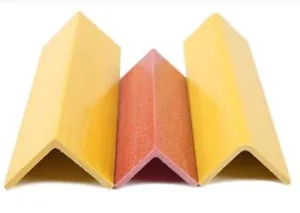Introduction
In recent years, FRP angle iron has emerged as a popular choice in various industries due to its exceptional properties and versatile applications. Unlike traditional materials such as steel and aluminum, FRP (Fiberglass Reinforced Plastic) offers a unique combination of strength, durability, and resistance to environmental factors. This article explores the benefits, uses, and reasons why FRP angle iron outperforms traditional materials in many applications.

frp angle iron
What is FRP Angle Iron?
FRP angle iron is a structural shape made from fiberglass reinforced plastic. It is composed of a polymer matrix reinforced with fibers, typically glass fibers, which provide exceptional strength and rigidity. Developed initially for aerospace and defense applications, FRP has found its way into numerous industries due to its advantageous properties.
Benefits of FRP Angle Iron
One of the primary benefits of FRP angle iron is its lightweight nature combined with high strength. This makes it easier to handle and install compared to traditional materials. Additionally, FRP is highly resistant to corrosion, making it ideal for use in harsh environments where metal would typically degrade. The material also provides excellent electrical and thermal insulation, reducing the risk of accidents and improving safety. Furthermore, FRP angle iron requires minimal maintenance and offers a long lifespan, reducing overall costs.
Common Uses of FRP Angle Iron
FRP angle iron is widely used in industrial applications due to its durability and resistance to chemicals. It is also favored in construction and infrastructure projects, especially in areas exposed to moisture and corrosive elements. In marine and coastal applications, FRP’s resistance to saltwater makes it a superior choice. Additionally, it is used in electrical and utility applications for its insulating properties and non-conductive nature.
FRP Angle Iron vs. Traditional Materials
When compared to traditional materials like steel and aluminum, FRP angle iron stands out for its cost-effectiveness and environmental benefits. FRP is lighter, reducing transportation and installation costs. Its resistance to corrosion means fewer replacements and repairs, saving both money and resources. Environmentally, FRP production has a lower carbon footprint, and its long lifespan further reduces environmental impact. Performance-wise, FRP offers better durability and flexibility in design.
Properties of FRP Angle Iron
FRP angle iron boasts impressive mechanical properties, including high tensile strength and impact resistance. Its chemical resistance ensures it remains unaffected by most acids, alkalis, and solvents. The design flexibility of FRP allows it to be molded into various shapes and sizes, catering to specific application needs.
Conclusion
In conclusion, FRP angle iron is a highly advantageous material that offers numerous benefits over traditional materials. Its lightweight, high strength, corrosion resistance, and low maintenance make it a preferred choice across various industries. Whether for industrial, construction, marine, or electrical applications, FRP angle iron proves to be a superior alternative. For more information or to get a quote, contact us today and discover how FRP can enhance your projects.




























